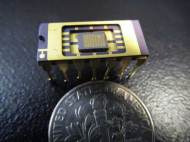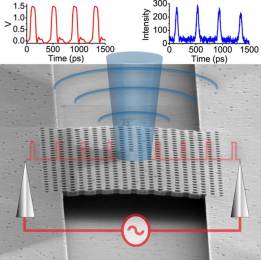Single-mode LED enables fast data transmition at low consumption
 A team of researchers from Stanford University School of Engineering has devised an ultrafast nanoscale light-emitting diode (LED) that is orders of magnitude lower in power consumption than today’s laser-based systems. It is also able to transmit data at the very rapid rate of 10 billion bits per second, making it suitable for use at on-chip data transmission.
A team of researchers from Stanford University School of Engineering has devised an ultrafast nanoscale light-emitting diode (LED) that is orders of magnitude lower in power consumption than today’s laser-based systems. It is also able to transmit data at the very rapid rate of 10 billion bits per second, making it suitable for use at on-chip data transmission.
Jelena Vuckovic, associate professor of electrical engineering at Stanford, came up with a nanoscale laser that was similarly efficient and fast earlier this year, but it was able to operate at very low temperatures which made it commercially unusable. Vuckovic and Gary Shambat, a doctoral candidate in electrical engineering, managed to develop a new device capable to operate at room temperature and could, therefore, represent an important step toward next-generation computer chips.
“Traditionally, engineers have thought only lasers can communicate at high data rates and ultralow power”, said Shambat. “Our nanophotonic, single-mode LED can perform all the same tasks as lasers, but at much lower power.”
In the heart of their device, the engineers have inserted little islands of indium arsenide – a material which emits light when pulsed with electricity. These “quantum dots” are surrounded by photonic crystal – an array of tiny holes etched in a semiconductor. The photonic crystal serves as a mirror that reflects the light toward the center of the device, confining it inside the LED and forcing it to resonate at a single frequency.
“Without these nanophotonic ingredients – the quantum dots and the photonic crystal – it is impossible to make an LED efficient, single-mode and fast all at the same time”, said Vuckovic. “Our device is some 2,000 times more energy efficient than best devices in use today.”
Unlike other existing devices, which consist of a laser coupled with an external modulator, the Single-mode LED developed by Stanford researchers combines light transmission and modulation functions into one device, thus reducing energy consumption. It consumes 0.25 femto-joules per bit of data, which is much lower compared to currently existing “low” power laser devices that require about 500 femto-joules for the same operation.
“Low-power, electrically controlled light sources are vital for next-generation optical systems to meet the growing energy demands of the computer industry”, said Vuckovic. “This moves us in that direction significantly.”
For more information, read the paper published in the journal Nature Communications named: “Ultrafast direct modulation of a single-mode photonic crystal nanocavity light-emitting diode“.










Leave your response!